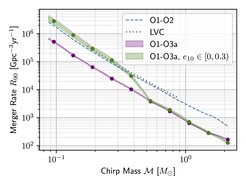Looking for the fossil black holes from the early Universe
The most sensitive search for primordial black holes
Using new LIGO/Virgo data from O3a (the first half of the third observing run), AEI scientists obtained the most sensitive search for primordial black holes formed in the early Universe. Primordial black holes may make up a part of dark matter, and may also explain the origin of some black hole mergers observed by LIGO and Virgo. To help answer these questions, the research team conducted the most sensitive search for binary black hole mergers in which the mass of at least one smaller black hole is less than that of our Sun. Black holes this small must be of primordial origin. No signals were found. Their lack places limits 3 to 4 times more constraining than those from earlier searches on the potential population of primordial black holes in our Universe.
Paper abstract
We present a search for gravitational waves from the coalescence of sub-solar mass black hole binaries using data from the first half of Advanced LIGO and Virgo’s third observing run. The observation of a sub-solar mass black hole merger may be an indication of primordial origin; primor- dial black holes may contribute to the dark matter distribution. We search for black hole mergers where the primary mass is 0.1 − 7 M⊙ and the secondary mass is 0.1 − 1 M⊙. A variety of models predict the production and coalescence of binaries containing primordial black holes; some involve dynamical assembly which may allow for residual eccentricity to be observed. For component masses > 0.5 M⊙, we also search for sources in eccentric orbits, measured at a reference gravitational-wave frequency of 10 Hz, up to e10 ∼ 0.3. We find no convincing candidates and place new upper limits on the rate of primordial black hole mergers. The merger rate of 0.5-0.5 (1.0-1.0) M⊙ sources is < 7100 (1200) Gpc–3yr–1. Our limits are ~ 3 – 4 times more constraining than prior analyses. Finally, we demonstrate how our limits can be used to constrain arbitrary models of the primordial black hole mass distribution and merger rate.













